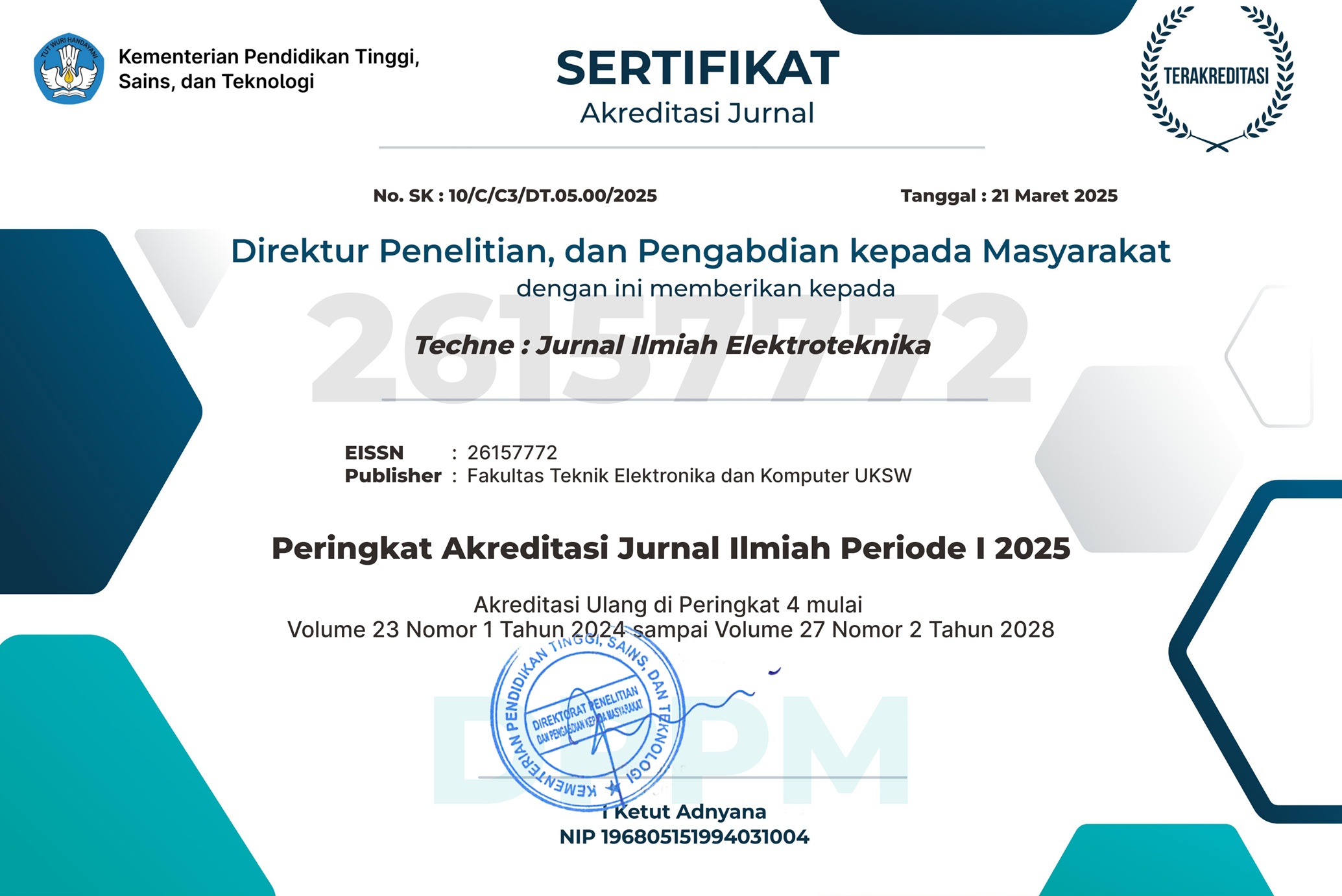Identifikasi Mangga Arumanis yang Dimatangkan dengan Kalsium Karbida (CaC2) Menggunakan Metode Spektroskopi
DOI:
https://doi.org/10.31358/techne.v22i1.368Keywords:
spektroskopi, fluoresensi klorofil, spektrometer mikro, mangga Arumanis, kalsium karbidaAbstract
Penggunaan kalsium karbida (CaC2) atau karbit untuk mematangkan buah dapat berbahaya untuk kesehatan, karena pada kulit dan daging buah terdeteksi unsur logam berbahaya, seperti fosfor dan arsenik. Oleh karena itu, dibutuhkan metode yang dapat digunakan untuk mengidentifikasi buah yang dimatangkan menggunakan karbit. Pada penelitian ini diusulkan sebuah metode spektroskopi untuk mengidentifikasi mangga Arumanis yang dimatangkan menggunakan karbit. Spektrum fluoresensi klorofil (ChlF) yang dipancarkan mangga saat disinari dengan sinar ungu akan diukur dan dianalisis untuk membedakan mangga yang matang alami dan mangga yang dimatangkan dengan menggunakan karbit. Dari hasil pengujian diperoleh bahwa puncak spektrum ChlF dari mangga yang matang alami lebih rendah dari pada puncak spektrum ChlF mangga yang dimatangkan dengan menggunakan karbit. Dengan memanfaatkan batas nilai rasio dua puncak pada spektrum ChlF (I683/I731 = 1,27) yang diujikan pada 120 data spektrum ChlF mangga Arumanis, diperoleh akurasi identifikasi mangga matang alami sebesar 85% dan akurasi identifikasi mangga matang karbit sebesar 80,83%.
Downloads
References
S. Singal, M. Kumud, and S. Thakral, “Application of apple as ripening agent for banana,” Indian J. Nat. Prod. Resour., vol. 3, no. 1, pp. 61–64, 2012.
S. D. T. Maduwanthi and R. A. U. J. Marapana, “Induced ripening agents and their effect on fruit quality of banana,” Int. J. Food Sci., vol. 2019, 2019, doi: 10.1155/2019/2520179.
S. Hassan, W. Mazhar, S. Farooq, A. Ali, and S. G. Musharraf, “Assessment of heavy metals in calcium carbide treated mangoes by inductively coupled plasma-mass spectrometry (ICP-MS),” Food Addit. Contam. - Part A Chem. Anal. Control. Expo. Risk Assess., vol. 36, no. 12, pp. 1769–1776, 2019, doi: 10.1080/19440049.2019.1671990.
D. R. Babu, R. Deshmukh, K. V. N. Rao, M. R. Laxmi, Kafila, and T. Sabita, “Awareness on Calcium Carbide Ripened Fruits and Recommendations for Toxic Free Artificial Ripening of Fruits,” Int. J. Eng. Adv. Technol., vol. 9, no. 2, pp. 2779–2783, 2019, doi: 10.35940/ijeat.b4059.129219.
A. J. Lakade, K. Sundar, and P. H. Shetty, “Gold nanoparticle-based method for detection of calcium carbide in artificially ripened mangoes (Magnifera indica),” Food Addit. Contam. - Part A Chem. Anal. Control. Expo. Risk Assess., vol. 35, no. 6, pp. 1078–1084, 2018, doi: 10.1080/19440049.2018.1449969.
R. Chandel, P. C. Sharma, and A. Gupta, “Method for detection and removal of arsenic residues in calcium carbide ripened mangoes,” J. Food Process. Preserv., vol. 42, no. 2, 2018, doi: 10.1111/jfpp.13420.
A. J. Lakade, V. Venkataraman, R. Ramasamy, and P. H. Shetty, “NIR spectroscopic method for the detection of calcium carbide in artificial ripening of mangoes (Magnifera indica),” Food Addit. Contam. - Part A Chem. Anal. Control. Expo. Risk Assess., vol. 36, no. 7, pp. 989–995, 2019, doi: 10.1080/19440049.2019.1605206.
M. Asif, “Physico-chemical properties and toxic effect of fruit-ripening agent calcium carbide,” Ann. Trop. Med. Public Heal., vol. 5, no. 3, p. 150, 2012, doi: 10.4103/1755-6783.98602.
W. Puspitaningrum and S. Supatman, “Identifikasi Mangga Harum Manis Karbitan dan Tidak Karbitan Dengan Learning Vector Quantization,” JMAI (Jurnal Multimed. Artif. Intell., vol. 2, no. 2, pp. 29–36, 2018, doi: 10.26486/jmai.v2i2.88.
M. N. Islam, M. Mursalat, and M. S. Khan, “A review on the legislative aspect of artificial fruit ripening,” Agric. Food Secur., vol. 5, no. 1, pp. 1–10, 2016, doi: 10.1186/s40066-016-0057-5.
N. I. Shaeda, R. Irniza, M. P. Sarva, and Z. A. Emilia, “Calcium carbide (CaC2 ) exposure from fruit ripening process and health effects among fruit farmers: A research review,” Int. J. Public Heal. Clin. Sci., vol. 5, no. 2, pp. 2289–7577, 2018.
A. T. Lacap, E. R. V. Bayogan, L. B. Secretaria, C. D. S. Lubaton, and D. C. Joyce, “Responses of ‘carabao’ mango to various ripening agents,” Philipp. J. Sci., vol. 148, no. 3, pp. 513–523, 2019.
A. J. Das, A. Wahi, I. Kothari, and R. Raskar, “Ultra-portable, wireless smartphone spectrometer for rapid, non-destructive testing of fruit ripeness,” Sci. Rep., vol. 6, no. August, pp. 1–8, 2016, doi: 10.1038/srep32504.
P. Palpandian, H. Shanmugam, E. Alli Rani, and G. T. V. Prabu, “Determination of fruit quality of calcium carbide induced ripening in mango (Mangifera indica L. cv. alphonso) by physiological, biochemical, bio-enzymatic and elemental composition analysis (EDX),” Indian J. Biochem. Biophys., vol. 56, no. 3, pp. 205–213, 2019.
E. N. Obledo-Vázquez and J. Cervantes-Martínez, “Laser-induced fluorescence spectral analysis of papaya fruits at different stages of ripening,” Appl. Opt., vol. 56, no. 6, p. 1753, 2017, doi: 10.1364/ao.56.001753.
Downloads
Published
How to Cite
Issue
Section
License
Copyright (c) 2023 Primus Putra Wahyudi, Budi Harsono

This work is licensed under a Creative Commons Attribution-NonCommercial-ShareAlike 4.0 International License.








